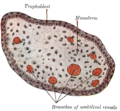Trophoblast
Trophoblast[edit]

The trophoblast is a layer of tissue on the outside of a mammalian blastocyst, supplying the embryo with nourishment and later forming a major part of the placenta. It is the first cell lineage to differentiate from the fertilized egg and plays a crucial role in implantation and interaction with the maternal endometrium.
Development[edit]

The trophoblast differentiates from the outer layer of the blastocyst during early embryogenesis. It surrounds the inner cell mass and the blastocoel, and it is responsible for the implantation of the embryo into the uterine wall. The trophoblast further differentiates into two layers: the cytotrophoblast and the syncytiotrophoblast.
Cytotrophoblast[edit]
The cytotrophoblast is the inner layer of the trophoblast, consisting of individual cells that retain their cell membranes. It serves as a source of new cells for the syncytiotrophoblast.
Syncytiotrophoblast[edit]
The syncytiotrophoblast is the outer layer of the trophoblast, which is a multinucleated cell mass that invades the uterine wall to establish nutrient circulation between the embryo and the mother. It secretes enzymes that allow the blastocyst to penetrate the uterine lining.
Function[edit]

The primary function of the trophoblast is to facilitate the exchange of nutrients and waste products between the mother and the developing embryo. It also produces hormones such as human chorionic gonadotropin (hCG), which is crucial for maintaining the corpus luteum and the early stages of pregnancy.
Pathology[edit]

Abnormalities in trophoblast development can lead to pregnancy complications such as preeclampsia, gestational trophoblastic disease, and ectopic pregnancy. In ectopic pregnancies, the trophoblast implants outside the uterine cavity, often in the fallopian tube, leading to potential rupture and hemorrhage.
Related pages[edit]
References[edit]
<references group="" responsive="1"></references>
-
Diagram of Blastocyst stage
-
Embryonic Disc, Amniotic Cavity, Yolk Sac
-
Trophoblast
-
Trophoblast
-
Trophoblast
-
Trophoblast
-
Human Embryogenesis
-
Histopathology of tubal pregnancy
Ad. Transform your life with W8MD's Budget GLP-1 injections from $75


W8MD offers a medical weight loss program to lose weight in Philadelphia. Our physician-supervised medical weight loss provides:
- Weight loss injections in NYC (generic and brand names):
- Zepbound / Mounjaro, Wegovy / Ozempic, Saxenda
- Most insurances accepted or discounted self-pay rates. We will obtain insurance prior authorizations if needed.
- Generic GLP1 weight loss injections from $75 for the starting dose.
- Also offer prescription weight loss medications including Phentermine, Qsymia, Diethylpropion, Contrave etc.
NYC weight loss doctor appointmentsNYC weight loss doctor appointments
Start your NYC weight loss journey today at our NYC medical weight loss and Philadelphia medical weight loss clinics.
- Call 718-946-5500 to lose weight in NYC or for medical weight loss in Philadelphia 215-676-2334.
- Tags:NYC medical weight loss, Philadelphia lose weight Zepbound NYC, Budget GLP1 weight loss injections, Wegovy Philadelphia, Wegovy NYC, Philadelphia medical weight loss, Brookly weight loss and Wegovy NYC
|
WikiMD's Wellness Encyclopedia |
| Let Food Be Thy Medicine Medicine Thy Food - Hippocrates |
Medical Disclaimer: WikiMD is not a substitute for professional medical advice. The information on WikiMD is provided as an information resource only, may be incorrect, outdated or misleading, and is not to be used or relied on for any diagnostic or treatment purposes. Please consult your health care provider before making any healthcare decisions or for guidance about a specific medical condition. WikiMD expressly disclaims responsibility, and shall have no liability, for any damages, loss, injury, or liability whatsoever suffered as a result of your reliance on the information contained in this site. By visiting this site you agree to the foregoing terms and conditions, which may from time to time be changed or supplemented by WikiMD. If you do not agree to the foregoing terms and conditions, you should not enter or use this site. See full disclaimer.
Credits:Most images are courtesy of Wikimedia commons, and templates, categories Wikipedia, licensed under CC BY SA or similar.
Translate this page: - East Asian
中文,
日本,
한국어,
South Asian
हिन्दी,
தமிழ்,
తెలుగు,
Urdu,
ಕನ್ನಡ,
Southeast Asian
Indonesian,
Vietnamese,
Thai,
မြန်မာဘာသာ,
বাংলা
European
español,
Deutsch,
français,
Greek,
português do Brasil,
polski,
română,
русский,
Nederlands,
norsk,
svenska,
suomi,
Italian
Middle Eastern & African
عربى,
Turkish,
Persian,
Hebrew,
Afrikaans,
isiZulu,
Kiswahili,
Other
Bulgarian,
Hungarian,
Czech,
Swedish,
മലയാളം,
मराठी,
ਪੰਜਾਬੀ,
ગુજરાતી,
Portuguese,
Ukrainian






